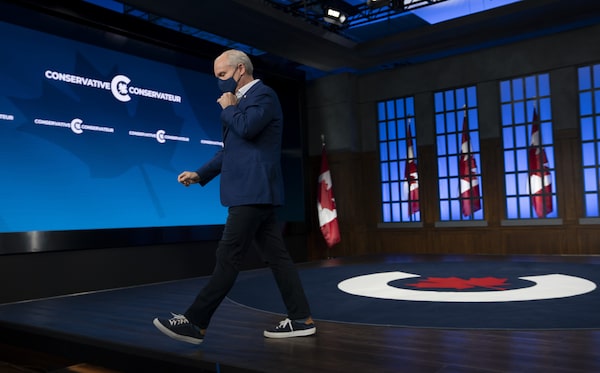
Politics is a game of inches, and the riding-by-riding breakdown shows that Mr. O’Toole came within inches of a much better result.Adrian Wyld/The Canadian Press
In the 2019 election, the two federal parties capable of forming government revealed their Achilles’ heels.
For the Liberals the soft spot was, of course, Western Canada. If you had got into a car in a Liberal-held riding in suburban Vancouver on a Monday morning in late 2019, and started driving east, and kept on driving for eight hours a day, it would have been sundown on Wednesday before you hit another Liberal seat. Between Vancouver and Winnipeg, there were none.
But the 2019 Conservatives had an even bigger problem: They were an endangered species in the parts of Canada that are growing, namely the cities.
With the exception of Calgary, Edmonton and parts of Metro Vancouver, if a riding wasn’t at least partly farmland or small towns, its MP in 2019 almost certainly wasn’t a Conservative. In the City of Toronto, home to more people than Saskatchewan and Manitoba combined, there were zero Conservative seats. In the rest of the Greater Toronto, with nearly as many people as Alberta, there were just a handful of Conservative seats.
In Greater Montreal, home to more than four million people, and where you’d have to employ carbon dating to identify the last time Conservatives were competitive, the closest Tory seat was in Ontario. The urban aversion to electing Conservatives extended to Ottawa, Winnipeg, Halifax, Hamilton, Windsor, London and Kitchener-Waterloo.
So what changed in Election 2021? In terms of the total number of seats won by each party, almost nothing. But in terms of where those seats are, the picture got brighter for the Liberals, and darker for the Conservatives.
The Liberals became a bit less central Canadian, while the Tories became a bit more rural. That is, of course, the opposite of what Conservative Leader Erin O’Toole was aiming for.
Last week, the Conservatives lost four seats in B.C. – all in suburban Vancouver. They lost three seats in Alberta – all in Edmonton and Calgary. Two incumbents from the GTA went down to defeat, leaving the party holding just five of 53 Toronto-area ridings.
They partly made up those losses by capturing four seats in rural Atlantic Canada – four new MPs from the shrinking parts of the slowest-growing provinces.
Mr. O’Toole’s goal was to break the Liberal-New Democrat stranglehold on Canada’s booming cities. The roster of MPs in the next Parliament will show that did not happen.
But give Mr. O’Toole credit for two major things.
First, he aimed at the right target. The Conservative Party has to appeal to voters in urban and suburban Canada, and win many ridings there, if it ever wants to form government again. It’s hard to see how that can happen without a shift to the centre on a number of issues. If the Conservatives become the official party of the hinterlands, they’re doomed.
Second, politics is a game of inches, and the riding-by-riding breakdown shows that Mr. O’Toole came within inches of a much better result.
We count 20 seats where the Conservative candidate lost by a margin of fewer than 2,000 votes. Just 24,000 extra votes, spread across those ridings, would have seen 20 more Tory MPs going to Ottawa.
An extra 2,100 hundred votes across two Edmonton ridings, and those seats would have remained blue. If the Tories could have found an additional 5,100 votes spread in the right places in four B.C. ridings, their caucus would be four MPs larger. Fewer than 3,500 votes distributed across three close races in the Kitchener-Waterloo area would have done the trick. Just 1,450 additional votes would have won the GTA riding of Aurora-Oak Ridges-Richmond Hill.
And in the GTA, Canada’s biggest urban prize, the Tories are more popular than their seat count suggests. They captured more than 31 per cent of the vote across the region, though the way it broke translated into just 9 per cent of the seats.
Canada is mostly urban and suburban, and becoming more so every day. In fact, the map of Parliament will be redrawn over the next couple of years, in light of the 2021 census. Since the last census, Metro Vancouver has gained more than 400,000 people. Calgary added more than 300,000, Ottawa a quarter-million, Montreal more than half a million, and the GTA roughly one million people.
All those places will be getting more seats before the next election. That’s the Conservative Party’s future.
Keep your Opinions sharp and informed. Get the Opinion newsletter. Sign up today.